Enchidos: must-try Portuguese sausages and cured meats
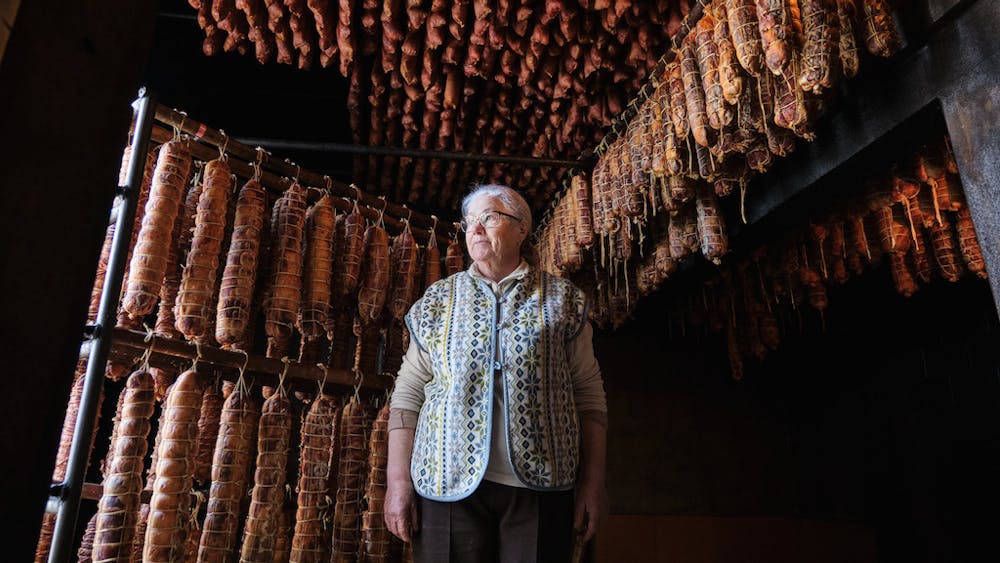
We can’t talk about Portugal’s gastronomic traditions without highlighting enchidos, that is, our country’s range of sausages and cured meats.
Translating literally, enchidos mean “stuffed”, suggesting the way meats and trimmings are typically preserved inside casings, in the shape of a sausage. Nor all Portuguese enchidos are actually stuffed, but what they do have in common is their capacity to conserve food and maintain it edible and appetizing over long periods of time.
Traditionally, when most of the people lived in villages, pigs were raised to be slaughtered once a year, right before winter would start. This would represent a great feast for the family, neighbors and friends, and it still does in some parts of the country. This day known as matança do porco, would include a big banquet of fresh pork cuts for lunch, and it would also be when the enchidos production would start. Before the elements could start deteriorating the meat, it was time to preserve it for it to last all winter long, while also developing different flavors. Between the fresh meat and the enchidos, pigs were indeed slaughtered, but their lives were honored by making good use of the entire animal, quite literally, from head to tail.
While not all Portuguese sausages are made of pork, the truth is that the vast majority do derive from pork, so much so that even the pig’s intestines are used as sausage casings. There are only three Portuguese autochthonous breeds of pig: the piebald malhado de Alcobaça, the DPO Bísaro from Trás-os-Montes, and the famous DPO Alentejano, the Iberian black pigs known for their deeply flavored succulent meat. It only takes three varieties of pig to make hundreds of variations of sausages, that are based on centuries old recipes, but that take on new flavors with regional condiments, techniques and smoking approaches.
This is the ultimate list of Portuguese cured sausages
Presunto
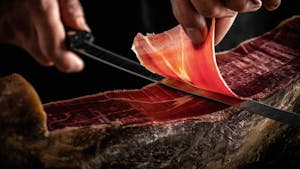 The Portuguese cousin of Italian prosciutto and Spanish jamón, presunto consists of a cured back leg of a pig. The entire leg is salted and left to cure, and it can sometimes also be smoked, but this is not a necessary step. The meat isn’t cooked but, instead, it is aged, and it is thanks to salt, time and specific low temperature and fairly high humidity conditions, that the meat dries and the flavor develops. As the time goes by, it is normal for the ham to be covered in a fungus called Penicillium Roquefortis, which is the same one that we can observe in cheeses like Roquefort. This fungus will be crucial for the flavor development. Presunto is left to cure for at least 9 to 12 months but, generally speaking, the longer the cure the higher the quality of the ham and, therefore, it will be sold at a price to match.
The Portuguese cousin of Italian prosciutto and Spanish jamón, presunto consists of a cured back leg of a pig. The entire leg is salted and left to cure, and it can sometimes also be smoked, but this is not a necessary step. The meat isn’t cooked but, instead, it is aged, and it is thanks to salt, time and specific low temperature and fairly high humidity conditions, that the meat dries and the flavor develops. As the time goes by, it is normal for the ham to be covered in a fungus called Penicillium Roquefortis, which is the same one that we can observe in cheeses like Roquefort. This fungus will be crucial for the flavor development. Presunto is left to cure for at least 9 to 12 months but, generally speaking, the longer the cure the higher the quality of the ham and, therefore, it will be sold at a price to match.
Portugal’s most famous cured hams include those made from Iberian black pigs from the Alentejo, like the one from Barrancos, and those made with the northern Bísaro breed, such as the ones from Barroso or Melgaço. To fully appreciate the delicate texture of presunto and its depth of flavor, enjoy it cut into thin slices.
Chouriço
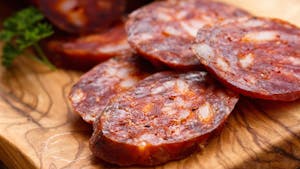 If by any chance you know Spanish or Mexican chorizos, keep in mind that chouriço from Portugal has its own peculiarities. In fact, chouriço is an umbrella that houses different types of cured and smoked sausages. Quite probably the most popular of all Portuguese enchidos, chouriço is prepared with pork meat, and heavily flavored with paprika, wine and garlic. This mix of condiments is known in Portuguese as vinha d’alhos, a blend that is behind what later came to be known as vindaloo in Portuguese influenced India. The proportion of meat and fat used to make a chouriço varies according to the recipe and the region of Portugal. This mix is stuffed inside pork tripe casings, which are tied up in the extremities, and hang in a rod to be smoked. The curing process may take between a few days and a few weeks.
If by any chance you know Spanish or Mexican chorizos, keep in mind that chouriço from Portugal has its own peculiarities. In fact, chouriço is an umbrella that houses different types of cured and smoked sausages. Quite probably the most popular of all Portuguese enchidos, chouriço is prepared with pork meat, and heavily flavored with paprika, wine and garlic. This mix of condiments is known in Portuguese as vinha d’alhos, a blend that is behind what later came to be known as vindaloo in Portuguese influenced India. The proportion of meat and fat used to make a chouriço varies according to the recipe and the region of Portugal. This mix is stuffed inside pork tripe casings, which are tied up in the extremities, and hang in a rod to be smoked. The curing process may take between a few days and a few weeks.
Short chouriços are normally cooked, either roasted on their own to be enjoyed above a slice of bread, or most generally cut into thick pieces and added to stews and rice dishes for flavoring. A longer, wider and slightly lighter sausage, chourição, is consumed mostly as thin slices inside sandwiches.
Some of Portugal’s most peculiar chouriços, include:
- chouriço mouro: a southern variety, with higher blood content and therefore a darker color than the regular chouriço;
- chouriço doce de Vinhais: made with added blood and honey;
- chouriço de cebola: flavored with onions and parsley;
- chouriço de abóbora: a PGI enchido from Barroso-Montalegre, sweetened with pumpkin.
If you come across chouriça instead of chouriço, note that the meats are essentially the same, but the difference is the casing used to contain and shape the sausage. While chouriço uses pig intestines, chouriça is made by filling sheep’s intestines, thus resulting in a longer and thinner sausage. If you are in the North of Portugal, in the Minho and Trás-os-Montes regions, both terms can be used interchangeably.
Linguiça
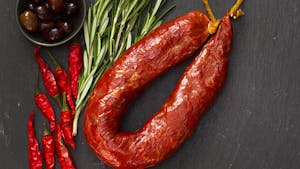 Linguiça, a thinner and longer chouriço look-alike, is sometimes also the international name used for chouriço in several parts of the world that have historically been influenced by Portugal and our food culture. It is not uncommon to find linguiça in former Portuguese territories in Asia such as Macao and Goa, where the lines between linguiça and Goan chouriço are blurred these days. In Hawaii, having linguiça for breakfast, alongside American staples like eggs and pancakes, is not unusual, thanks to the influx of Portuguese immigrants that went to the islands to work in sugar cane plantations in the 19th century.
Linguiça, a thinner and longer chouriço look-alike, is sometimes also the international name used for chouriço in several parts of the world that have historically been influenced by Portugal and our food culture. It is not uncommon to find linguiça in former Portuguese territories in Asia such as Macao and Goa, where the lines between linguiça and Goan chouriço are blurred these days. In Hawaii, having linguiça for breakfast, alongside American staples like eggs and pancakes, is not unusual, thanks to the influx of Portuguese immigrants that went to the islands to work in sugar cane plantations in the 19th century.
As such, it’s hard to define with certainty what a linguiça is all about. But, here in Portugal, we still see it as a thinner chouriço, also more concentrated in terms of flavor. This sausage which originated in the south of Portugal, is usually consumed cooked, cut into slices and added to typical recipes. You will not normally see linguiça served as a part of a typical Portuguese charcuterie board. Instead, look for it as a part of stews or, at the most, grilled on its own.
Alheira
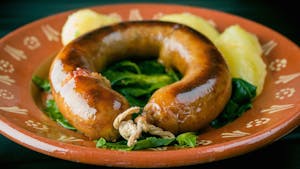 If all Portuguese enchidos have a rich history, alheira is certainly the one that stands out because of the inventive way it came to be. Back in 15th century Portugal, the Jews were being persecuted and forced to convert to Christianity. These New Christians were supposed to conform to the traditions of the christian majority, and that included consuming pork, a forbidden ingredient in Jewish dietary laws. Many Jews from back then officially assumed their new faith, while they kept practicing their beliefs behind closed doors. They ended up surviving like this for centuries, until freedom of religion was a reality in Portugal, like it is today. But centuries ago, that’s when Jews developed alheiras, made with poultry and game meats such as hare, duck and partridge. Shaped to resemble a pork sausage, and hung over the fireplace at home for anyone who’d come by to see, they would fool those who could otherwise feed their suspicions about the true faith of the so-called New Christians.
If all Portuguese enchidos have a rich history, alheira is certainly the one that stands out because of the inventive way it came to be. Back in 15th century Portugal, the Jews were being persecuted and forced to convert to Christianity. These New Christians were supposed to conform to the traditions of the christian majority, and that included consuming pork, a forbidden ingredient in Jewish dietary laws. Many Jews from back then officially assumed their new faith, while they kept practicing their beliefs behind closed doors. They ended up surviving like this for centuries, until freedom of religion was a reality in Portugal, like it is today. But centuries ago, that’s when Jews developed alheiras, made with poultry and game meats such as hare, duck and partridge. Shaped to resemble a pork sausage, and hung over the fireplace at home for anyone who’d come by to see, they would fool those who could otherwise feed their suspicions about the true faith of the so-called New Christians.
Nowadays, you can find two types of alheira. Alheira de caça, considered by purists as the real alheira, is still made with game meat, chicken and, in some cases, veal. On the other hand, and quite ironically, the most widespread alheiras today are those made with pork meat, just like other sausages. The northern Trás-os-Montes towns of Mirandela, Montalegre and Vinhas are particularly famous for their alheiras. These are prepared with a mix of pork and chicken, bound together with olive oil and bread, and seasoned with garlic, salt and paprika.
Alheira is always consumed cooked, either fried or grilled, served as petisco, or as a full dish, with sides such as fries, rice, sauteed greens or salad. Alheiras also feature heavily in typical Portuguese stews or snacks such as fritters.
Farinheira
 The name farinheira comes from the Portuguese word for flour, farinha. Yet another Jewish creation made to resemble a pork sausage, dating back to the days of the Inquisition. Originally made with wheat flour, pepper paste, paprika and wine, as fate had it, farinheira also ended up incorporating pork fat somewhere along history. Back then and today, the blend of farinheira is first boiled and then put into pork casings to be smoked. They have a characteristic starchy, not too greasy smooth texture, with a deep smoked flavor, ideal to enhance other dishes more than being consumed on its own.
The name farinheira comes from the Portuguese word for flour, farinha. Yet another Jewish creation made to resemble a pork sausage, dating back to the days of the Inquisition. Originally made with wheat flour, pepper paste, paprika and wine, as fate had it, farinheira also ended up incorporating pork fat somewhere along history. Back then and today, the blend of farinheira is first boiled and then put into pork casings to be smoked. They have a characteristic starchy, not too greasy smooth texture, with a deep smoked flavor, ideal to enhance other dishes more than being consumed on its own.
Farinheira is a classic presence in old-time Northern dishes, but it also features heavily in contemporary Portuguese cuisine, either in the shape of croquetes, scrambled with eggs, or used as stuffing for puff pastry and other leaner meats like chicken.
Morcela
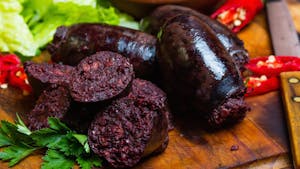
Also known as chouriço de sangue, that is blood sausage, morcelas are found all over Portugal but are most typical in the center and south of the country, as well as in our Atlantic islands. This sausage makes good use of the pig’ blood, traditionally seen as a great source of nutrition.
Besides blood and meat, regional recipes for morcela may vary and include other ingredients such as rice, bread and onions. They are usually flavored with spices like cumin and clove, responsible for mellowing down the strong flavor of the blood, adding aromas that are enhanced by the time morcelas spend aging in the smokehouse. To the contrary of other enchidos which tend to be salty, morcelas are slightly sweet, with a fatty but not too overpowering inside. One of the best ways of eating morcela, apart from sliced into stews, is grilled until the skin becomes perfectly crisp, served with Azores pineapple, which pairs beautifully with this sausage, as the acidity of the juicy fruit compliments the unctuosity of the meat.
Paio
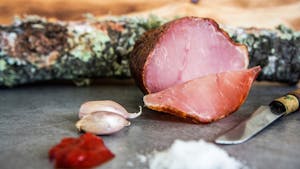
Paio, or paio do lombo, is considered a noble type of enchido, as it is made with pork loin. Being a more expensive and delicately flavored cured meat, it isn’t usually used for cooking, but instead cherished in charcuterie boards or in sandwiches. As the meat is already of high quality, paio doesn’t involve as many condiments as other enchidos. The simply flavored pork loin with salt and garlic is wrapped inside the pig’s stomach, to be first boiled and afterwards air-dried. Unlike other Portuguese cured meats, or unless the word fumado is added to its name, paio is not smoked. The meat is tender and slightly salty.
Paio is especially well known in the south of the country, in the Alentejo. Paios from Beja and Barrancos are particularly famous. These regions have a long tradition of producing high-quality paio, in weather conditions that are conducive for the naturally drying process of this cured meat.
Paio branco, or white paio, is a peculiar variety of paio, also from the Alentejo. This type of paio is lighter in appearance, something explained by the local flora that makes up the diet of the pigs in the region. Smokehouses are filled with the flavoring powers of holm-oak, to give this type of paio a smoky taste.
Paiola is a more humble version of paio, which instead of using pork loin alone, employs other cheaper cuts of pork such as legs, shoulders and neck. Paiola is generally darker than paio, more fat marbled, and may also be flavored with red wine.
Salpicão
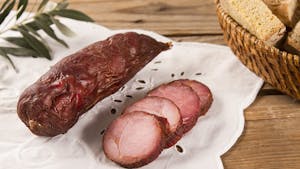
A close relative of paio, salpicão is made of an amalgamation of pieces of meat, which may include pork loin and leg. Before being stuffed inside a large pork intestine casing, the meats are left in a marinade of red wine, garlic, paprika, bay leaf, salt and pepper over a few days. Salpicão is left to air-dry for at least one week, with a few moments of smoke during the day to help develop the flavors.
Typical of Trás-os-Montes and the Douro regions, salpicão has been consumed since the 18th century. Unlike other Portuguese sausages, salpicão isn’t fatty. The meat is lean, salty and firm, perfect to be sliced.
Butelo
 Butelo or botelo, also known as chouriço de ossos from Vinhais, is the only Portuguese sausage made with pork bones. It is made with pork ribs and bits of the delicious meat surrounding it, cartilage and vertebrae. This may sound off putting at first, but after the tidbits are seasoned in a marinade with wine, garlic, bay leaf, paprika and salt, and smoked for a few weeks, butelo really does turn into an appetizing enchido.
Butelo or botelo, also known as chouriço de ossos from Vinhais, is the only Portuguese sausage made with pork bones. It is made with pork ribs and bits of the delicious meat surrounding it, cartilage and vertebrae. This may sound off putting at first, but after the tidbits are seasoned in a marinade with wine, garlic, bay leaf, paprika and salt, and smoked for a few weeks, butelo really does turn into an appetizing enchido.
Even though butelo comes from the latin bottellus, meaning tripe, this bone chouriço can be stuffed inside pork stomach, bladder or tripe, always in a thick, unevenly round and slightly spiky shape, which can weigh up to two kilos.
Butelo is mostly eaten in and around Bragança, in a traditional preparation as seen here, that pairs the enchido with boiled potatoes and dried bean peels, known in Portuguese as casúlas.
Cacholeira
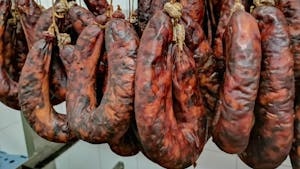 Cacholeira is an PGI sausage from Montalegre, in the Alentejo, that instead of focusing on pork’s blood, is made with fat and offal such as liver, heart, pancreas and kidney. Cacholeira’s seasonings include wine, garlic and cumin. After marinating for about a day, the meats for cacholeira are boiled for an hour. Roasting cacholeira is also an option. Either way, cacholeira is always eaten cooked, such as in the Alentejo’s version of the Portuguese meats stew cozido à portuguesa.
Cacholeira is an PGI sausage from Montalegre, in the Alentejo, that instead of focusing on pork’s blood, is made with fat and offal such as liver, heart, pancreas and kidney. Cacholeira’s seasonings include wine, garlic and cumin. After marinating for about a day, the meats for cacholeira are boiled for an hour. Roasting cacholeira is also an option. Either way, cacholeira is always eaten cooked, such as in the Alentejo’s version of the Portuguese meats stew cozido à portuguesa.
Cacholeira’s distinctive taste doesn’t only derive from the seasonings, but also from the diet of the Iberian black pigs which feeds mostly in the wild with acorns.
Maranho
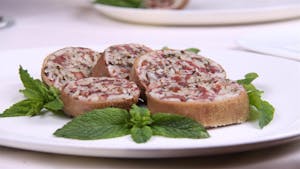
At last a sausage that isn’t made out of pork – maranho, also known as maranho da Sertã after the city where it was created, is a fresh sausage stuffed inside a goat or sheep’s stomach. Not very commonly found elsewhere in Portugal, maranho can be tasted in the Beira Baixa region, where it features in very traditional menus or during specific festivities.
Maranho consists of a blend of goat or lamb and pork meats, namely chouriço and presunto bits, with rice, white wine, olive oil, and mint. Its flavor is sharper than most other pork enchidos, and this is why the freshness of mint is crucial for a well balanced maranho. Maranho is always consumed cooked. It can be simply boiled, or boiled and then roasted for a crunchier exterior. Ideal side dishes for this enchido include boiled vegetables and sour leafy greens that contrast with the fattiness and heaviness of maranho.
Tripa enfarinhada
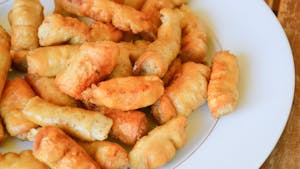 Hailing from the northern Minho and Douro Litoral regions, tripa enfarinhada is a long thin sausage made with pork tripe, corn flour, pepper and cumin. It was traditionally prepared on the day the house pig was slaughtered, but now-a-days you can find it at the butcher or even the supermarket, particularly up north.
Hailing from the northern Minho and Douro Litoral regions, tripa enfarinhada is a long thin sausage made with pork tripe, corn flour, pepper and cumin. It was traditionally prepared on the day the house pig was slaughtered, but now-a-days you can find it at the butcher or even the supermarket, particularly up north.
Tripa enfarinhada is prepared cut into small pieces or slices to be deep-fried, as seen here. It is eaten either as an appetizer or as a side dish for Porto’s typical cubed pork meat dish rojões à moda do Porto.
Many of these Portuguese sausages are an essential part of Portugal’s most traditional recipes, responsible for providing protein but, above all, for deepening the flavors of the dishes. Besides hearty meals, enchidos can be enjoyed in sharing platters known in Portuguese as tábuas, alongside our rich selection of regional cheeses.
What Portuguese enchidos have you tried before? We’d love to read about how you liked them via Instagram or Facebook. Please tag us: @tasteoflisboa #tasteoflisboa
Feed your curiosity on Portuguese food culture:
Petiscos: the most popular Portuguese tapas
Homestyle Portuguese food for the winter
Foods you didn’t know were Portuguese
The most iconic traditional grocery stores in Lisbon
Real people, real food. Come with us to where the locals go.
Signup for our natively curated food & cultural experiences.
Follow us for more at Instagram, Twitter e Youtube
